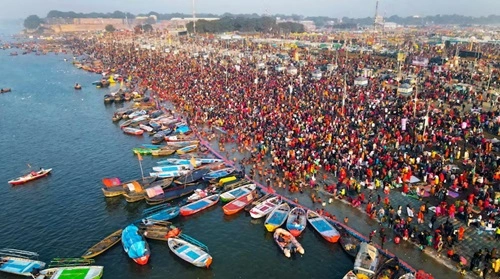The world’s largest religious congregation is projected to generate over ₹3 lakh crore in economic activity
The Maha Kumbh Mela 2025, currently underway in Prayagraj, Uttar Pradesh, is not only a monumental spiritual event but also a significant economic catalyst. According to the Confederation of All India Traders (CAIT), this year’s festival is expected to generate business exceeding ₹3 lakh crore (approximately USD 360 billion) through various goods and services, marking it as one of India’s most substantial economic events to date.
Unprecedented Attendance and Economic Impact

Spanning from January 13 to February 26, the 45-day Maha Kumbh Mela is anticipated to attract nearly 60 crore (600 million) devotees from across the globe. This massive influx of pilgrims has led to a surge in demand across multiple sectors, including hospitality, transportation, food and beverages, religious paraphernalia, handicrafts, textiles, healthcare, and telecommunications. The CAIT highlights that the festival has bolstered local trade, with a notable increase in sales of Maha Kumbh-themed products such as diaries, calendars, jute bags, and stationery, driven by meticulous branding efforts.
Infrastructure Investments and Regional Benefits
To accommodate the vast number of visitors, the Uttar Pradesh government has invested approximately ₹7,500 crore in enhancing Prayagraj’s infrastructure, including the construction of flyovers, roads, and underpasses. These developments aim to ensure the smooth movement and safety of pilgrims throughout the festival. The economic benefits of the Maha Kumbh extend beyond Prayagraj; cities and towns within a 150 km radius have experienced a significant uptick in business activities, strengthening local economies. Additionally, other religious destinations such as Ayodhya and Varanasi have seen increased pilgrim visits, further fueling economic growth in these regions.
A Fusion of Tradition and Technology
This year’s Maha Kumbh Mela has been dubbed the ‘Digital Maha Kumbh’ due to the integration of advanced technologies aimed at enhancing the experience and safety of attendees. Authorities have implemented AI-based facial recognition systems, extensive CCTV surveillance, and crowd monitoring software to manage the massive gatherings effectively. These technological measures have been instrumental in preventing incidents and ensuring the well-being of pilgrims.
Challenges Amidst the Celebrations
Despite meticulous planning and infrastructure enhancements, the festival has faced challenges due to the overwhelming number of attendees. Tragically, a stampede occurred on January 29, resulting in several fatalities and injuries. This incident underscores the complexities involved in managing such a colossal congregation and highlights the need for continuous improvements in crowd control and safety measures.
Conclusion
The Maha Kumbh Mela 2025 exemplifies the profound connection between cultural heritage and economic vitality. The festival not only offers a platform for spiritual enrichment but also serves as a powerful engine for economic development, benefiting a wide array of sectors and regions. As the event progresses, it continues to set new benchmarks in blending tradition with modernity, showcasing India’s ability to honor its rich cultural past while embracing technological advancements for a prosperous future.

